Dell Studio XPS 16: the Eyes Have It
by Jarred Walton on April 2, 2009 6:00 PM EST- Posted in
- Laptops
Gaming Performance
We've chosen to focus on "reasonable" settings for the games below. That means we run Assassin's Creed and Company of Heroes in DX9 mode at maximum detail setting - DX10 reduces performance by quite a bit in AC and by a much larger amount in CoH. We run Crysis at Medium settings (for reference, High detail drops performance almost in half: 8.8 FPS for the XPS 16 at 1680x1050). The remaining games are at maximum detail settings, but without any anti-aliasing.
Again, we chose to focus on 1680x1050 as a baseline performance comparison, and we will do so with other laptops going forward. If necessary, we will use an external LCD to run at that resolution. Besides 1680x1050, we will also include results at the native LCD resolution, and for less powerful laptops like the Studio XPS 16 we will add 1280x800 performance. (Note that performance at 1366x768 - a 16:9 aspect ratio - is virtually identical to results at 1280x800.) Ideally, you would want to run any laptop at the native LCD resolution, but depending on the game and your hardware that may not be practical.

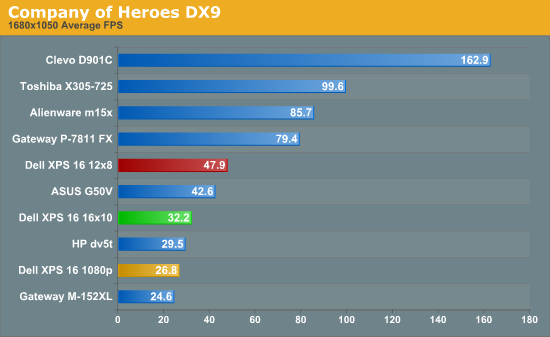
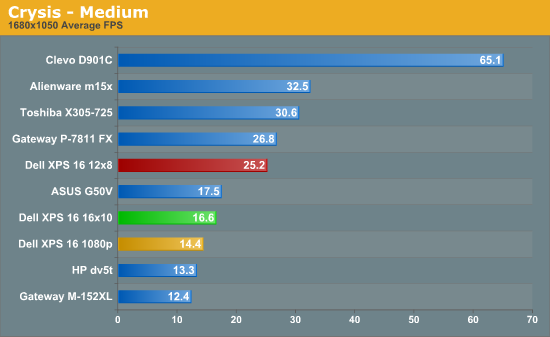
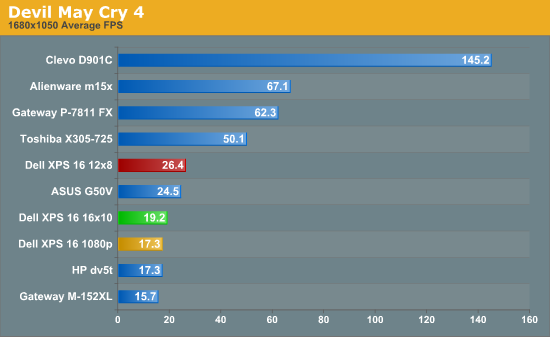
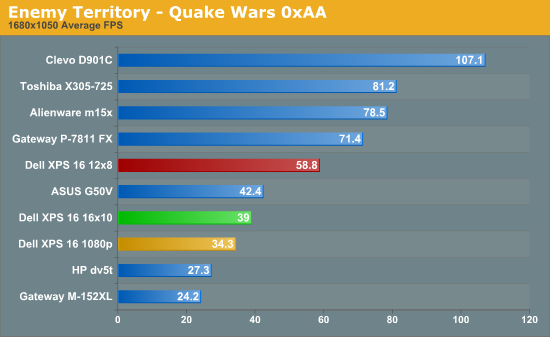
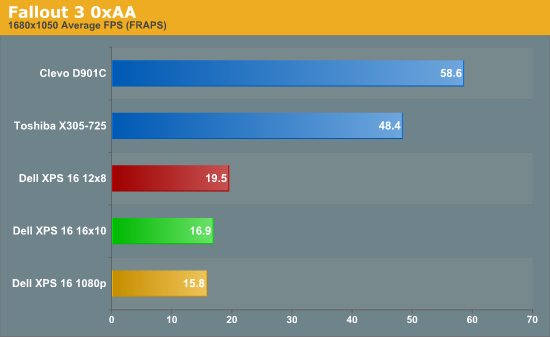
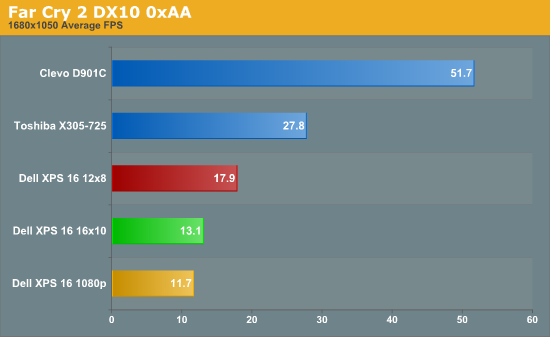
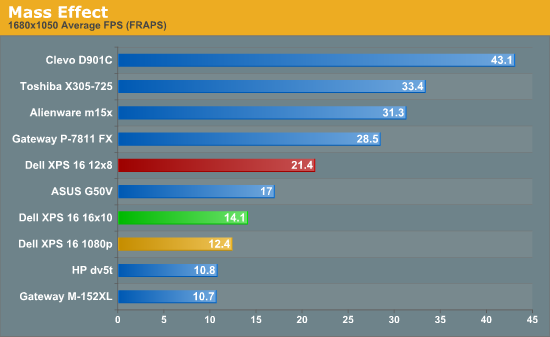

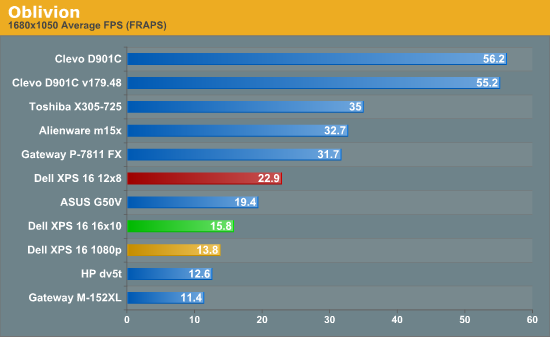
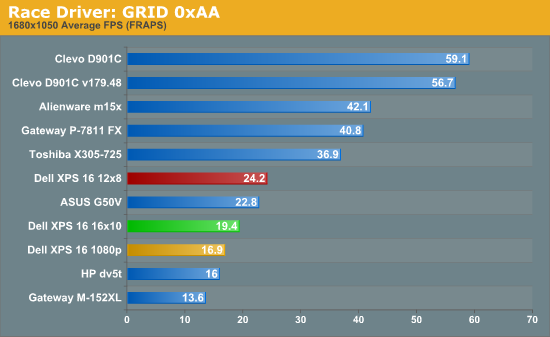
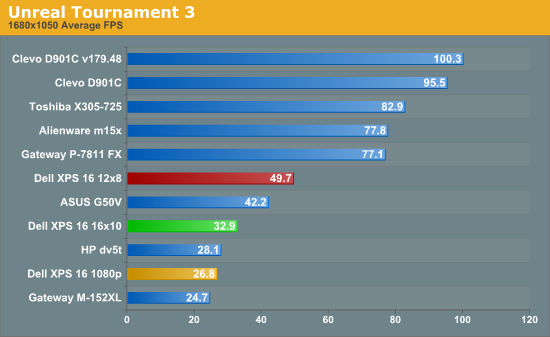
The gaming results are what you would expect from a Radeon HD 3670. If you look at the green bar, which represents equivalent performance at 1680x1050, the Studio XPS 16 is slower than the GeForce 9700M GT in the ASUS G50V but stays well ahead of the GeForce 9600M GT in the HP dv5t. Another way of looking at it is that performance at 1280x800 is almost equal to what you can get from the 9700M GT at 1680x1050; conversely, 1080p performance essentially matches the 9600M GT at 1680x1050.
As we mentioned earlier, we performed the initial benchmarks using outdated drivers. Updating to the latest drivers from Dell's website improved performance by 3-5% in several titles that we checked (Far Cry 2, Crysis, and Unreal Tournament 3). That's not a big enough change to affect the standings or our recommendation, but if you get an XPS 16 you'll want to verify that you're running the latest drivers.
Put simply, if you are interested in purchasing a laptop that can provide reasonable gaming performance, you really need at least a GeForce 9700M and preferably a 9800M - or a Mobility Radeon HD 4650 and preferably a 4830 from the ATI side. It's not that you can't game on lower end graphics solutions, but there are plenty of titles where you will need to drastically reduce resolution or detail settings in order to provide acceptable frame rates. As far as ATI versus NVIDIA goes, the latest ATI products do a great job at closing the performance gap that has existed for a while now in the mobile sector - we will have a look at a notebook in the near future that might even take the performance crown from NVIDIA.
The driver situation muddies the waters greatly, however, and we would really have a difficult time recommending against NVIDIA for a high-end gaming laptop unless and until ATI begins to offer "mobile reference drivers". Yes, it's possible to hack desktop drivers and make them work, but that definitely isn't the preferred solution. It's also a little disconcerting that when you go to ATI's website and look for Mobility Radeon drivers, many options aren't even listed - for example, the 3600 series used in the Studio XPS 16 is entirely absent. NVIDIA also has CUDA and PhysX to further tilt the scales in their favor, if you buy into the marketing. Overall, the Mobility HD 3670 is decent, but there are now better options. Unfortunately, adoption of new mobile GPUs often lags behind their official release by several months, which is why this new Studio XPS 16 uses a GPU that launched early last year.










79 Comments
View All Comments
RU482 - Friday, April 3, 2009 - link
ANy idea what the make/model of the LCD panel?JarredWalton - Friday, April 3, 2009 - link
See the test system page. It looks like a Seiko Epson M077D€160HT according to ASTRA32, but that may or may not be correct.rudy - Thursday, April 2, 2009 - link
The specs for all the machines would be really important here. And they should be included. Why is something like the macbook air which is no where near as powerful even in such a line up? If it is then why aren't other notebooks which pack battery life of an entire day put in there?rudy - Thursday, April 2, 2009 - link
You cannot seriously tell me that the best battery life per watt hour notebook running windows is an alienware seriously...JarredWalton - Thursday, April 2, 2009 - link
Look at the specifics of that Alienware. It's running with the X3100 IGP instead of the discrete GPU. That's why I harp on the need for every other laptop to allow such functionality.As for the remaining laptops, they're all in previous reviews on our site, under the Mobile tab. I just don't think it's necessary to include all 15 or whatever notebook configs in each review. I suppose I can post links to the config pages for reference, though.
As for the MacBook Air, performance isn't super high, but it still has a reasonable Core 2 Duo CPU and I believe NVIDIA IGP, which means performance isn't exactly terrible. There are other notebooks in those charts that aren't particularly high-end as well.
rudy - Thursday, April 2, 2009 - link
The keypad missing on this 16 inch model is a real downer. The space is there I think.JarredWalton - Thursday, April 2, 2009 - link
It's possible to fit in a keypad, but then the rest of the keyboard isn't centered. I have a 15.4" notebook I'm testing with a number keypad and overall I prefer the XPS 16 layout. Then again, that may have more to do with the keyboard on that other laptop simply being super flimsy.... Anyway, the XPS M1730 is still my favorite laptop keyboard, as it's the best of both worlds. It *should* be able to fit on the Studio XPS 16, but for whatever reason Dell didn't go that route.Hrel - Thursday, April 2, 2009 - link
Yeah, good job Jarred Walton; you included 3D Mark results, and not just some of them, frickin' ALL of them... lol. I guess Dereck and Anand could learn a thing or two from you. (That last sentence is said partially sarcastic and no disrespect is meant.) I added that cause that sentence kinda makes me sound like a prick, which I'm not.JarredWalton - Thursday, April 2, 2009 - link
My laptop tests have always included them, but I *really* don't put much stock in 3DMark. I include them simply because they're easy enough to run. Start, walk away, come back in a while and collect the results. I wish more of the game tests were that easy. :)Wesleyrpg - Friday, April 3, 2009 - link
Nice review jarred,i been looking at one of these to replace my XPS m1530, but am concerned that the 3670 is weaker than my 8600mGT in the gaming departmrnt....i'm an AVID WoW player, so which do you think will perform better in WoW?
Also.....those 3dmark scores, were there done in the displays natural resolution or 3dmarks default resolution?
Thanks and keep up the good work